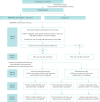A feasibility cluster randomised controlled trial of a paramedic-administered breathlessness management intervention for acute-on-chronic breathlessness (BREATHE)
- PMID: 33816602
- PMCID: PMC8005684
- DOI: 10.1183/23120541.00955-2020
A feasibility cluster randomised controlled trial of a paramedic-administered breathlessness management intervention for acute-on-chronic breathlessness (BREATHE)
Abstract
Chronic breathlessness, persistent and disabling despite optimal treatment of underlying causes, is a prevalent and frightening symptom and is associated with many emergency presentations and admission to hospital. Breathlessness management techniques used by paramedics may reduce the need for conveyance to hospital. The Breathlessness RElief AT HomE study (BREATHE) aims to explore the feasibility of conducting a definitive cluster randomised controlled trial (cRCT) for people with acute-on-chronic breathlessness who have called an ambulance, to evaluate the effectiveness and cost-effectiveness of a paramedic-administered non-pharmacological breathlessness intervention. The trial is a mixed-methods feasibility cRCT. Eight paramedics will be randomised 1:1 to deliver either the BREATHE intervention in addition to usual care or usual care alone at call-outs for acute-on-chronic breathlessness. Sixty participants will be recruited to provide access to routine data relating to the index call-out with optional follow-up questionnaires at 14 days, 1 month and 6 months. An in-depth interview will be conducted with a subgroup. Feasibility outcomes relating to recruitment, data quality (especially candidate primary outcomes), and intervention acceptability and fidelity will be collected as well as providing data to estimate a sample size for a definitive trial. Yorkshire and The Humber-Sheffield Research Ethics Committee approved the trial protocol (19/YH/0314). The study results will inform progression to, or not, and design of a main trial according to predetermined stop-go criteria. Findings will be disseminated to relevant stakeholders and submitted for publication in a peer-reviewed journal.
Copyright ©The authors 2021.
Conflict of interest statement
Conflict of interest: M. Northgraves has nothing to disclose. Conflict of interest: J. Cohen reports grants from the NIHR during the conduct of the study. Conflict of interest: V. Allgar has nothing to disclose. Conflict of interest: D. Currow reports he is an unpaid advisory board member for Helsinn Pharmaceuticals. He is a paid consultant and receives payment for intellectual property with Mayne Pharma and is a consultant with Specialised Therapeutics Australia Pty. Ltd. Conflict of interest: S. Hart reports personal fees and nonfinancial support from Chiesi UK; and grants, personal fees and nonfinancial support from Boehringer Ingelheim, all outside the submitted work. Conflict of interest: K. Hird has nothing to disclose. Conflict of interest: A. Hodge has nothing to disclose. Conflict of interest: M. Johnson has nothing to disclose. Conflict of interest: S. Mason has nothing to disclose. Conflict of interest: F. Swan has nothing to disclose. Conflict of interest: A. Hutchinson has nothing to disclose.
Similar articles
-
Mixed-methods feasibility cluster randomised controlled trial of a paramedic-administered breathlessness management intervention for acute-on-chronic breathlessness (BREATHE): study findings.ERJ Open Res. 2022 Nov 21;8(4):00257-2022. doi: 10.1183/23120541.00257-2022. eCollection 2022 Oct. ERJ Open Res. 2022. PMID: 36415651 Free PMC article.
-
A feasibility, randomised controlled trial of a complex breathlessness intervention in idiopathic pulmonary fibrosis (BREEZE-IPF): study protocol.ERJ Open Res. 2019 Oct 21;5(4):00186-2019. doi: 10.1183/23120541.00186-2019. eCollection 2019 Oct. ERJ Open Res. 2019. PMID: 31649946 Free PMC article.
-
Feasibility study of a multicentre cluster randomised control trial to investigate the clinical and cost-effectiveness of a structured diagnostic pathway in primary care for chronic breathlessness: protocol paper.BMJ Open. 2021 Nov 23;11(11):e057362. doi: 10.1136/bmjopen-2021-057362. BMJ Open. 2021. PMID: 34815293 Free PMC article.
-
A randomised, controlled, feasibility trial of an online, self-guided breathlessness supportive intervention (SELF-BREATHE) for individuals with chronic breathlessness due to advanced disease.ERJ Open Res. 2023 Apr 11;9(2):00508-2022. doi: 10.1183/23120541.00508-2022. eCollection 2023 Mar. ERJ Open Res. 2023. PMID: 37057089 Free PMC article.
-
PATCH: posture and mobility training for care staff versus usual care in care homes: study protocol for a randomised controlled trial.Trials. 2018 Sep 24;19(1):521. doi: 10.1186/s13063-018-2863-5. Trials. 2018. PMID: 30249295 Free PMC article.
Cited by
-
Mixed-methods feasibility cluster randomised controlled trial of a paramedic-administered breathlessness management intervention for acute-on-chronic breathlessness (BREATHE): study findings.ERJ Open Res. 2022 Nov 21;8(4):00257-2022. doi: 10.1183/23120541.00257-2022. eCollection 2022 Oct. ERJ Open Res. 2022. PMID: 36415651 Free PMC article.
-
Predictors of hospital admission when presenting with acute-on-chronic breathlessness: Binary logistic regression.PLoS One. 2023 Aug 15;18(8):e0289263. doi: 10.1371/journal.pone.0289263. eCollection 2023. PLoS One. 2023. PMID: 37582083 Free PMC article.
References
LinkOut - more resources
Full Text Sources
Other Literature Sources
Miscellaneous

